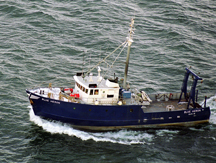Researchers to study Lake Michigan currents with scientific vessel
July 10, 2013
 |
|
Purdue researchers are spending a week near the middle of Lake Michigan, about 50 miles southeast of Milwaukee, aboard the Blue Heron research vessel, seen here. They will be tracking a fluorescent plume of dyed water to study how currents transport contaminants and aquatic life. (University of Minnesota-Duluth, Large Lakes Observatory photo/Brett Groehler) |
WEST LAFAYETTE, Ind. – Researchers from Purdue University are spending a week aboard a scientific vessel in Lake Michigan, tracking a fluorescent plume of dyed water to study how currents transport contaminants and aquatic life.
The five-member team, which includes four students, will conduct research aboard the Blue Heron for seven days beginning Sunday (July 14). The experiment is being conducted in the middle of the lake, about 50 miles southeast of Milwaukee.
"The goal is to do a dye-release experiment and to track the dye patch over time to see where it diffuses and where it moves and to relate that to the information we have about the lake currents and waves," said Cary Troy, an assistant professor in Purdue's School of Civil Engineering. "One obvious application is for something like an oil spill or any sort of contaminant spill in the Great Lakes. If you have a spill, you need to predict where it's going to go and how quickly it's going to dissipate."
Findings also could help to better understand movement of organisms such as plankton and fish larvae.
"Data will be used to improve computer models of how these things are circulated and transported in the Great Lakes," said Troy, who is working with doctoral student Jun Choi, undergraduate David Cannon and two other students.
The research vessel is operated with funding from the University-National Oceanographic Laboratory System, a group of academic institutions and national laboratories involved in oceanographic research. The vessel is part of a fleet associated with the National Science Foundation's Division of Ocean Sciences, and the research is funded by NSF's Physical Oceanography Program.
Research findings could apply to any of the Great Lakes and other large bodies of water, including oceans
The non-toxic dye, called Rhodamine WT, is initially bright pink and later is not detectable by the naked eye. The researchers will track it using equipment called a fluorometer, which detects dye fluorescence. The fluorometer is mounted to an instrument package that is towed behind the ship and controlled so that it undulates up and down, a technique called Tow-Yo. The up-and-down movement enables researchers to create a two-dimensional scan of the dye patch.
"Then, we will go back and forth in sort of a grid pattern while we are Tow-Yoing, providing a three-dimensional view of the dye patch," Troy said.
The research is needed in part because, unlike oceans, the Great Lakes lack the predictable regularity of tides. Instead, Lake Michigan currents are determined by a combination of factors including winds and water temperatures that vary according to depth. These factors combine to cause a complex, spiraling water flow, producing a type of wave called an inertial wave.
"You can get currents as strong as a half-meter per second in the middle of Lake Michigan," Troy said. "The effect is strongest in the middle of each of the Great Lakes, so that's why we are doing the research there. We don't have tides in Lake Michigan, but we do have inertial waves, and these waves can often cause tidal-like behavior in the lake's interior in terms of their strength and regularity."
The researchers hypothesize that the waves govern dispersion of particles in the interior of the Great Lakes.
In addition to the fluorometer, researchers will use devices called drifters to track the dye. The buoy-like drifters flow with currents using underwater sails. They are equipped with GPS systems and beam their location to a satellite every hour. The real-time positions provided by the drifters will help guide the researchers as they attempt to follow the drifting dye patch over the seven-day cruise. The NOAA Great Lakes Environmental Research Laboratory in Ann Arbor, Mich. is providing real-time forecasts of the dye-patch location.
Writer: Emil Venere, 765-494-4709, venere@purdue.edu
Source: Cary Troy, 765-494-3844, troy@purdue.edu
